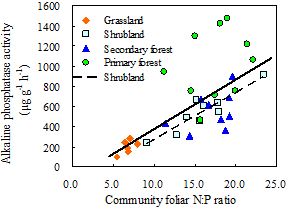Plant and Soil:中科院亚热带生态所揭示西南喀斯特生态系统养分循
Plant and Soil发表中国科学院亚热带农业生态研究所环江喀斯特站养分循环研究团队对西南喀斯特生态系统养分循环特征的研究论文,该研究得到国家重点基础研究发展计划、中科院百人计划项目、国家自然科学基金及中科院“西部之光”人才培养计划等项目的资助。
养分对生态系统生产力和其他生态过程的限制在陆地生态系统广泛存在。养分限制不仅影响生态系统持续的碳固定,还制约着其他生态系统功能的维持。氮(N)和(P)被认为是陆地生态系统最主要的两种限制性养分元素。在我国西南喀斯特地区,生态学家和土壤学家很早就注意到,由于石灰土的高pH和富钙(Ca)等特性,该地区植被群落普遍受P限制。但是强烈的人类活动(如毁林开荒和不合理的耕作)会改变养分循环的生态化学计量平衡,导致生态系统的养分限制因子发生改变。
上世纪50年代末以来,我国西南喀斯特地区大面积土地经历了从植被退化、石漠化到植被次生演替的历史变化。90年代后期国家重大生态工程的实施(退耕还林还草、生态移民与石漠化治理等),极大地促进了该地区植被恢复。但由于对植被演替过程中生源要素的生物地球化学循环规律缺乏充分认知,理论研究与工程治理脱节,该生态脆弱区植被恢复缓慢,在巨大的人口压力下,部分恢复土地又面临着二次退化的危险。因而,研究退化喀斯特生态系统植被恢复过程中养分限制规律,对该地区植被恢复重建和生态系统可持续管理均具有重要意义。
针对以上科学问题,中国科学院亚热带农业生态研究所环江喀斯特站养分循环研究团队选取不同演替阶段典型植被群落为研究对象(草丛、灌木林、次生林),以国家自然保护区原生林为参照,研究了喀斯特退化土地次生演替过程中生态系统的养分限制特征。结果发现,在历史耕作扰动期间,尽管N和P均会大量流失,但由于N和P对耕作扰动的响应不同,N的流失途径和流失量均多于P。如侵蚀和淋失均会导致N和P元素的流失,但由于P容易被土壤颗粒吸附,因而N(尤其是硝态氮)更易于淋溶丢失。而且在N转化过程中,大量的N素会以气体的形式丢失。同时,由于生态系统N和P的来源不同(N主要来源于大气,而P主要来源于基岩和母质风化),在生态系统恢复初期,植物可以通过出露及浅埋基岩的风化获取P。因此,喀斯特退化生态系统恢复初期(草丛阶段),植被群落主要受N限制。随着植被的正向演替,自生固氮和共生固氮过程逐渐恢复,N素迅速积累,而土壤P素在Ca和土壤矿物作用下多转化为无效态,因此在生态系统演替后期(次生林和原生林阶段),植被群落主要受P限制。在生态系统恢复中期(灌木林阶段),植被群落受N、P共同限制。以上研究表明,在退化喀斯特生态恢复重建初期应关注N素的输入管理,如豆科植物的引种和自生固氮过程的培育。

图1 西南喀斯特地区不同演替阶段群落叶片N:P比与土壤养分相关性分析

图2 西南喀斯特地区不同演替阶段群落叶片N:P比与土壤碱性磷酸酶活性相关性分析
原文链接:
Changes in nitrogen and phosphorus limitation during secondary succession in a karst region in southwest China
原文摘要:
Background and aimsNitrogen (N) and/or phosphorus (P) limitation to primary productivity and other biological processes can change in a variety of ways as ecosystems develop. How N limitation and P limitation change from the early to the late stages of a secondary succession following farmland abandonment remains unclear in karst ecosystems in southwest China.MethodsWe used community foliar N:P ratio, soil alkaline phosphatase activity (APA) and other indicators of nutrient status (soil organic carbon [SOC], total soil N [TN], and total soil P [TP], Alkali-hydrolyzable N [AN], and available soil phosphorus [AP] concentrations) to examine changes in N and P status during secondary vegetation succession. Four types of plant communities (grasslands, shrublands, secondary forest, and primary forest) represented the early, middle, late, and very late successional stages, respectively.ResultsCommunity foliar N:P ratio, APA, and APA per unit SOC increased as succession proceeded from the grassland to the secondary and primary forest communities. Moreover, community foliar N:P ratios in the grassland were positively correlated with soil TN, while community foliar N:P ratios in the secondary forest and primary forest were negatively correlated with soil TP, but were not correlated with soil TN. Community foliar N:P ratios in the shrubland were not correlated with either soil TN or TP.ConclusionsOur results suggest that the grassland in the karst region of southwest China is N limited, that the secondary and primary forests are P limited, and that the shrubland is constrained by N and P together or by other nutrients.
DOI:10.1007/s11104-015-2406-8
作者:Wei Zhang

